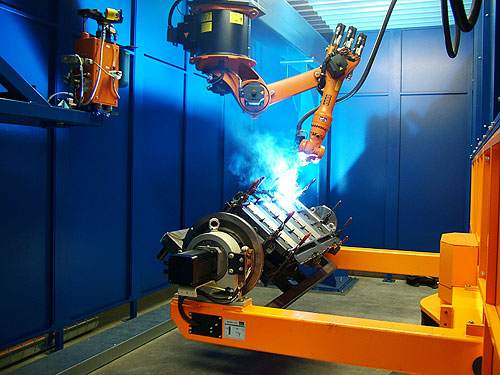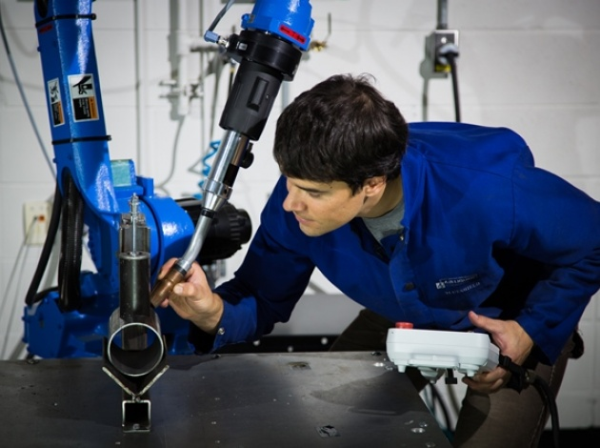What is Included in Robotic Welding Systems?

Posted on Oct 29, 2014 in Robotic Welding
5 min read time
Considering getting into robotic welding? This article should help you wrap your head around robotic welding systems. What's considered a basic necessity for these welding machines? What are the possible different accessories for a robotic welding cell.
Welding Robot
Of course... This is the basic component that everyone thinks about as it is the main component of the robotic cell. There are a lot of robot manufacturers out there that are manufacturing welding specific robots. And this is a good thing too, as there is a high demand for robot welders since human welders are hard to find. In fact, we have already created a comparative chart to help you choose the perfect robot for your applications. Specifications such as reach, IP rating, and repeatability are listed in this chart.
Welding Robot Controller
The robot controller is basically the brain of the robot. This is where all the programming and control is located. It transforms all the programming into the physical motions of the robot. It is normally bought with the robot. Each robot can have a different controller model, but usually a robot manufacturer will have a few robot controller models that go with a wide variety of robots. Ask your integrator or your robot salesperson to get more information on the right robot controller for your application.

However, the controller should not be confused with the teach pendant. The teach pendant is a user-friendly interface to teach motions or register points to the robot. You can think of it basically as the remote control for the robot. It is not the controller itself, but more of an input interface for the controller. So most robot controllers come with a teach pendant.
Welding Source
If you are already in the welding market you probably know what a welding source is. To make a long story short, the welding source provides the necessary electricity/power/heat to ''melt'' the metal at the end of the welding gun so that it can merge the 2 parts of metal together (weld). So the welding source drives the type of welding that can be done, the type of material you can weld, the power you can apply and the rated output. We also created a robotic welding power source comparative chart that can be consulted to review the latest available information.
Welding Gun
The welding gun will be chosen depending on the type of welding that will be done. Each welding type has particular requirements and methodologies. So depending on the type of welding process you are using, the welding gun can change. You can look at different welding processes on this blog post.
Welding Cell Enclosure
You probably know that welding involves a certain level of danger, mostly related to the spark generated or the gas that is expelled into the room. This is where enclosures are very useful, in fact, since a manual welding cell can be dangerous for the people around it, most shops install devices that cut the lights and suck all the gas out of the shop. The only difference with the robotic welder are the motions related to it. Since, motions performed by a robot welder run the possibility of causing harm to human workers, the shop must respect the appropriate norms on robot security, as well. So basically, there are two different functionalities for the enclosure around the robot welder. Robot safety and welding safety. The enclosure might be a solid, full metal plate instead of a fence so that light and gas cannot pass through the barrier. Make sure to read all the applicable norms thoroughly when building your own enclosure or ask your vendor or integrator what is the best proven enclosure for your robot.
Options for Welding Cells
Tables, Turntables, and Fixtures
These are an entire world in and of themselves. There are many components and accessories that can be add to the welding cell. From a simple table with clamps to a turntable encompassing external axes. Anything that you can think of can be introduced into your cell.
Tables are the most common device used to retain parts and weld them together. External axes can allow the parts to rotate while the robot is welding. For example, this might mean that a round pipe can be welded in a single operation, which would give more degrees of freedom to the robotic cell and optimize your welding production. A turntable can be used with ''tables'' or with external axes. Generally, a turntable is used to allow you to switch from one part to another. So while the robot is welding, an operator can install the next assembly to be welded on the second table. Once the robot is done, the table switches and the robot welds the new assembly while the operator removes the welded assembly and puts an new one in place. This allows for virtually zero downtime and can increase your production dramatically.

Robotic Torch Cleaning Station
When introducing a welding cell into a workshop your goal generally is to increase your production rate or to increase your precision. For both reasons your robot is going to work at a maximum pace and will have little time to recover between each welding operation. To make each weld nice and clean you have to make sure the welding gun/torch is always clean. A torch cleaning station can help with this and should be introduced into the robotic cell, so that it can be embedded in the robot program to assure that the torch is cleaned as much as possible. To optimize your welding time, the torch can be cleaned when the part is switched for example.
Linear Axis
For a long welding cell a linear axis can be useful. Now it's not the part that is moving, but the robot itself. In fact with this method, the robot can roll from one side of the part to the other which can increase the area range available to be welded. However, you need to make sure to have a good linear axis system that will reduce the error related to the robot's motion. You still want to weld with good accuracy, so if the robot goes 0.5 inch too far, you can get into trouble. You will have to make sure to reduce your errors as much as possible.
Welding Robot Teaching Device
A lot of people still think that programming a welding robot is complicated. Of course, it is!!!! However, some devices can make your life easier. In fact, devices such as, Kinetiq Teaching can be fitted onto your welding robot and can greatly reduce your programming time. This device provides a hardware and software package to teach your robot to weld. By hand-guiding the robot you can teach it the different points and motions that it will be welding. The software allows the user to register these points and motions with relative ease. Test runs and final adjustments can then be made to the welding path. This allows for a great weld every time and because the interface is so user-friendly now everyone can program a robot without in deep programming knowledge.
Related Blog Post:




Leave a comment